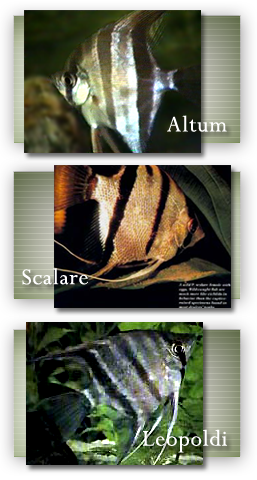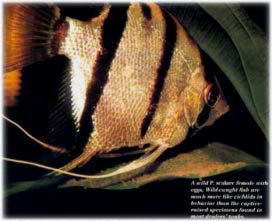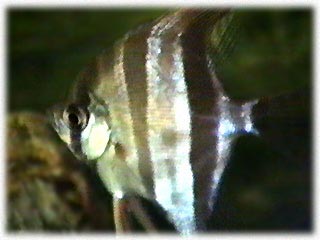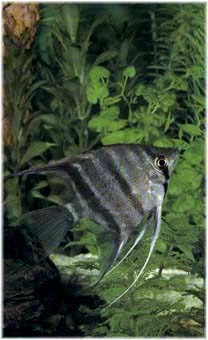|
I know it’s sometimes hard to believe that angelfish or
discus are really cichlids, let alone cichliasomines. They
certainly don’t look cichliasomine - and they don’t act like
cichlids. At least this is the case for the cultivar (man-made)
varieties, which have had most of the "cichlid" bred out of them
in the interests of "improving" their coloration or finnage.

Three
valid species of Pterophyllum:
Altum, Leopoldi, Scalare.
|
| Three
valid species of Pterophyllum. |
I won’t attempt an in-depth discussion of how to breed angels
and discus here. Instead, I will refer you to a number of
excellent articles and books that cover the topic well (e.g.,
Angelfish: Marks 1995, 1996: Discus: Schulze 1988). I would,
however, like to inform you of the charm and husbandry of
wild-caught angelfish and discus, which, along with the
redoubtable uaru, make up an interesting assemblage of highly
compressed "pancake" cichlasomines. Many of the wild forms are
as pretty or prettier than their cultivated counterparts! They
certainly are more the essence of cichlid and more challenging
to breed!
There are currently three valid, recognized species of
freshwater angelfish (Pterophyllum) species, including P altum,
P leopoldi and P scalare. They are readily recognizable by even
the rankest of beginners because of their (erroneous) reputation
as "beginner’s" fish. They are characterized by their dramatic
flatness (lateral compression), their triangular shape created
by the strongly elongated dorsal and anal fins, by their silvery
color with contrasting black vertical bars, and by their long,
modified ventral fin "feelers" (which they share with the
festivum, Mesonauta sp.). The highly compressed body and the
alternating stripes make them blend in with the vertical grasses
and plants, and the submerged branches in their natural
habitats. All three angelfish species exhibit, to a greater or
lesser extent, these unique (among cichlids) morphological
features. However, the differences among regional forms are
dramatic enough for ichthyologists to have classified several of
these as distinct species in their own right.
NOMENCLATURAL HISTORY
Burgess (1979) has reviewed, in highly readable fashion, the
nomenclatural history of the angelfishes, which I will summarize
here. Lichtenstein (1823) described Zeus scalaris from a single
specimen collected in Brazil. The type specimen, which was
deposited in the Berlin Museum, was later examined by Cuvier and
Valenciennes, who were unaware of Lichtenstein’s published
description. They renamed the fish Platax scalaris, but their
description was based on that single and apparently mutilated
specimen. Heckel, in 1840, redescribed this species based on
additional specimens from the Rio Negro. He erected the genus
Pterophyllum for it and included scalaris in this genus.
Pterophyllum means "winged leaf," referring to the highly
compressed body and finnage, and scalari means "ladder" or "stepped."
Castelnau (1855) described a second species of angelfish,
dumerilii, and, unaware of the work of Heckel, Cuvier and
Valenciennes, and of Lichtenstein, erected the genus Plataxoides
for it (the Greek root "plata" means flat). This was later
corrected by Gunther (1862), who actually synonymized all
(incorrectly in the case of P. dumerilii) as Pterophyllum
scalare, the current name of the "common" angelfish. The "altum"
angelfish was described by Pellegrin in 1903 as Pterophyllum
altum, and a fourth species, Pterophyllum eimekei, was added by
Ahi in 1928 - the latter based on aquarium (commercial)
material. Ahi’s species later proved to be identical to P.
scalare (Schultz 1967), although the name appears in aquarium
texts of the 1940s through the ‘60s.
Finally, J. P. Gosse described a fifth species in 1963 as
Plataxoides leopoldi, believing that Heckel’s genus name
Pterophyllum was already being used to describe a genus of
insects at the time of Heckel’s description. It wasn’t, and P.
leopoldi was judged by Schultz (1967) to be a synonym of P.
dumerilii. However, Sven Kullander (1986), re-examining the type
specimens of both P. dumerilii and P. leopoldi, concluded that
the holotype (single specimen used for classification) of P.
dumerilii was actually a variant of P. scalare, and that P.
leopoldi was distinct and valid.
His interpretation was based on head shape (predorsal
contour): P. dumerilli and P. scalare share a "notched" profile,
while P. leopoldi lacks the notch and has a conspicuous black
spot at the dorsal end of the fourth vertical bar. It is also
relatively squat and short finned relative to P. scalare and P.
altum. Kullander (1986) believes P. Ieopoldi bridges the
morphological gap between Pterophyllum and Mesonauta (festivum).
To make things even more confusing, Burgess (1976) had initially
concluded that P. scalare and P. altum were simply clinal
variants (endpoints of a morphological and geographical
gradient) and therefore the same morphologically variable
species (i.e., P. scalare). Later, Burgess (1979) suggested that
these be promoted to subspecies status (i.e., P. scalare scalare
and P. scalare altum). Review by Kullander (1986) of these two
forms suggested to him that P. altum and P. scalare were indeed
"good" species that could be separated unambiguously,
particularly with respect to the vertical barred patterns of
each: the bars of P altum are much wider.
Cichlid hobbyists who have seen P. altum and P. scalare I’m
sure will agree. However, Kullander (1986) suggests that the
"scalare" he examined from Guyana, Brazil and Peru vary in fin
and scale counts and coloration, and we may well see P. scalare
split into several additional distinct species in the years to
come. Indeed, wild P. scalare imported into the hobby from
different collecting locales (e.g., Guyana, Brazil, Peru) differ
in several obvious ways, including head profile, intensity of
vertical barring and the presence or absence and extent of red
spotting on the flanks.
So scientists and aquarists alike are currently dealing with
three species: P scalare, the typical silver angelfish found in
the Amazon from Peru through Brazil and into the Guyanas; P.
altum, the high-bodied Rio Orinoco and Rio Negro angelfish; and
P leopoldi, the "dumpy" angelfish from Guyana and the Rio Negro.
It is P scalare that has provided the genetic stock for all of
the myriad color/finnage mutants presently sold in the aquarium
trade. Both P altum and, particularly, P. Ieopoldi are rather
rare in the hobby, and have been spawned only occasionally. This
is because wild angelfish, unlike their cultivar descendants,
are rather demanding aquarium fish.

Pterophyllym Scalare
|
| Pterophyllym Scalare |
The SCALARE
In 1911 Pterophyllum scalare was first imported live into
Germany and into this country in 1913 by way of Germany in a
shipment arranged by members of the Brooklyn Aquarium Society (Nuoffer
1925). Apparently, one William L. Paullin of Pennsylvania was
the first to successfully breed them and raise fry in 1917. His
account is particularly interesting.
I kept this pair in a 125-gallon tank, well planted with
Sagittaria and kept the water at a temperature of 80 F, which
was made possible by the use of a large oil stove kept burning
directly beneath the aquarium. They first spawned in the summer
of 1915, depositing the spawn on the underside of a blade of
Sagittaria. . .It took about seven days before the little fish
were able to swim about freely, but at this time I lost them
all...This pair spawned four times in 1916 and each time I had
nothing to show for it. This was most unpleasant and caused me
to seek the cause of this great loss.
After taking everything into consideration, I came to the
conclusion that a constant supply of freshwater was what was
most needed: hence in 1917 1 made a gas hot water heater. This
permitted me to have a constant flow of water and at any desired
temperature. At the next spawning I placed the spawn in 5-gallon
glass jars, keeping the same supplied with a constant flow of
water at 85 degrees. This constant flow of water kept the grass
constantly in motion; the spawn hatched in regular time and at
seven days were swimming free.. .At this period I cut off the
running water, as I found they would be in danger of being
washed over the tops of the jars, and I took no chances of
losing them. In 1917 1 raised about 250 and 300 in 1918; these I
sent to various parts of the country” (Nuoffer 1925).
A little ingenuity and a lot of patience paid off thanks Mr.
Paullin. These were the starting population of most of the early
cultivated strains.Scalare are typically collected in whitewater
habitats or in turbid black waters (Kullander 1986), usually in
lakes or other slow-moving or still bodies of water (i.e.,
ponds, pools and so on: lentic environments). Typically, they
are associated with sunken wood and/or aquatic vegetation that
makes collecting difficult. Often they must be stunned as they
sleep by bright light (flashlight, headlamp) and hand netted one
by one. This informs us of our choice of aquarium aquascaping
for wild-caught specimens.
Because wild scalare can be quite aggressive (much more so
than cultivar angels), and grow fairly large (about 4 to 5
inches long, 6 to 8 inches high), larger tanks are necessary. I
recommend anything from 4 feet (60 to 90 gallons) to 6 feet (125
to 150 gallons) in length that is 18 to 24 inches wide. Water
quality is important, but the water shouldn’t be turbulent. Here
is one case where a canister filter used in conjunction with
internal air-driven box filters, or simple aeration, may do the
job. Equally useful, and cheaper (and easier to maintain) are
external power filters, but these shouldn’t “blow” the fish
around.
Although native whitewater can have average chemical parameters
(e.g., pH 7.2 to 7.4, moderate hardness), better success seems
assured with slightly acid (e.g., pH = 6.5) and soft water,
often with peat filtration as an adjunct (see Leibel 1993). The
temperature should be kept in the low to mid 80 degrees
Fahrenheit.
This is also an exceptional case for cichlids in which plants
are recommended! These can be Amazon swordplants (Echinodorus
sp.) or Sagittaria sp., perhaps potted, which provide shelter
and a place for egglaying. A centerpiece of bog wood is also
helpful.
Food for wild scalare should include good-quality frozen (e.g.,
bloodworms) and live (e.g., earthworms) foods, as well as
pelleted foods. Spawning can be induced, after conditioning the
fish, at higher temperatures (around 88 to 92 degrees
Fahrenheit) coupled with water changes.
I have yet to work seriously with wild scalare, and so have
not had the good fortune to breed them. But my good friend and
talented aquarist, Lee Newman of Vancouver, Canada, has, and I
will share his observations with you.
For starters, he collected his own from the Rio Ucayali basin
in Peru. He placed the eight adults he brought back into a
180-gallon aquarium that contained a base of fine sand and some
driftwood. The angels were housed with several Satanoperca sp.
(“jurupari”-type eartheaters) that enjoy similar conditions. The
pH was 6.5, the water had less than 1 degree of hardness, and
the temperature was maintained at 86 degrees Fahrenheit. (Unlike
Paullin in 1917, he didn’t need an oil stove to do that thanks
to the marvels of modern aquarium equipment!)
The fish were fed a diet of pelleted foods, frozen bloodworms
and live earthworms. After several months, a pair that had
formed became extremely aggressive, taking over one-half of the
6-foot tank. The fish were behaving as though they wanted to
spawn, but didn’t.
On a whim, Lee submersed a cutting of a monstera house plant (a
large, split-leaf tropical philodendron-type plant with broad
flat leaves). They laid eggs on it within just six hours!
Regrettably, the first spawn of several hundred eggs fungused.
The colony of angels, this time minus the eartheaters, were
moved to a 4-foot, 70-gallon tank set up with fine sand
substrate, driftwood and "the largest plastic Amazon swordplant
I could find." This time, two pairs spawned simultaneously: one
pair on the driftwood at one end, and the second pair on the
plastic plant. The remaining four angels clung to life in the
demilitarized zone in the middle of the tank.
The fry were tiny and were unable to eat newly hatched brine
shrimp until about seven days after they were free-swimming.
They were fed infusoria created by the old “hay infusion” method
that consists of letting hay (or a lettuce leaf) rot in a jar of
water.
Small angelfish lack the dramatically produced dorsal and
ventral finnage that characterize the species, and only acquire
these as they grow. The breeding scalare were extremely
parental, with the male even threatening onlookers through the
glass (they were behaving like real cichlids). They moved their
wrigglers around the tank, typically hanging them on the
driftwood or the plastic plant via the adhesive glands on their
heads, which secrete a mucilaginous "glue" (see photos of this
in White 1975). Interestingly, even after the fry were
free-swimming the parents gathered them just before “lights out”
and attached them by their heads to a leaf. After about 11 to 12
days post-spawn the parents abandoned care and prepared to spawn
again, which they did - cyclically - every 15 days.

Pterophyllym Altum
|
| Pterophyllym Altum |
ALTUM ANGELS
Anyone who has seen altum angels (P. altum) will attest to
the fact that they are quite distinct from P. scalare and much
more beautiful and delicate. For starters, they grow quite a bit
larger than the average P. scalare, reaching vertical heights
(anal fin to dorsal fin) of 12 to 15 inches and lengths of 6 to
8 inches. The biggest altum angel I ever saw was a single
specimen that swam in Jim Forshey’s community tank in Shingle
Springs, California. It was 8 inches long and 15 inches tall!
The bars are brown to cinnamon in color rather than black,
wider, and continue into the tail and the soft portions of the
dorsal and anal fins (P. scalare fins are clear). And their
heads have a distinctive "notch" or dip right above the eyes (superorbital)
that makes their mouths look long and pinched. (Some populations
of P. scalare share this trait to a lesser extent, as noted
above.)
The altum angel hails from the upper Rio Orinoco in Venezuela
and Colombia, and the Rio Negro of Brazil, with water conditions
that are similar to those for discus. That is, the pH is under
6.0, there is hardly any measurable hardness, and water
temperatures are 86 to 88 degrees Fahrenheit (Stawikowski and
Werner 1988). This, in part, is what makes altums more delicate
and difficult to keep as aquarium inhabitants.
There is, however, another factor: they apparently ship poorly
and are prone to sudden death by some “stealth” (possibly viral)
agent. In other words, they may look good one moment, and go
belly up for no apparent reason the next. At least that has been
my experience with newly imported stock direct from the
wholesaler. I recommend that you buy only specimens that have
been living in your dealer’s tanks for awhile, and I’d certainly
recommend quarantining any new altums you wish to add to an
established colony. I’ve made all these mistakes myself (see
Leibel 1995)!
As for their husbandry, the general outlines for P. scalare
detailed above are fine with respect to tank size, setup,
filtration and feeding. In addition, very soft, very acid water
(perhaps even reverse osmosis water) is recommended, coupled
with peat filtration and higher temperatures. Think wild discus
here. (But, don’t keep them together for reasons I’ll detail
when we talk about discus in the next installment.)
As for breeding them, it has been the fondest hope of many
advanced breeders, but only very few have succeeded. I know of
only one breeder who has achieved that goal (or so he says), and
I know of several very accomplished cichild aquarists, even
those who have made a commercial go of angelfish/discus
breeding, who are still trying.
Nevertheless, a large tank set up just for a colony of altums
(eight to 12) is a thing of rare beauty, and I’d highly
recommend it.

Pterophyllym Leopoldi
|
| Pterophyllym Leopoldi |
LEOPOLDI
It is unfortunate, but P leopoldi has sometimes been known in
the hobby as the “dumpy” angelfish on account of its squatter,
more elongate body and less dramatically extended dorsal and
anal fins. Nevertheless, the fish usually sold as P dumerilii in
the hobby (noted earlier) is a charming, if rare, fish. It hails
from the Rio Solimoes/Amazonas and from the Rio Rupununi in
Guyana, and is rarely imported.
It is distinguished by its shape, as reviewed above, and by
the presence of a dark blotch on the fourth vertical band on the
dorsum just below the point of dorsal fin insertion and on the
fin itself. Pterophyllum leopoldi presents few difficulties as
an aquarium resident if kept like P scalare.
This species has been bred on occasion, and tank-raised
juveniles are offered in the hobby on an irregular basis. They
continue to be coveted by dedicated angelfish enthusiasts, but
regrettably, they are rarely imported.
CONCLUSION
While cultivated strains of angelfish continue to enjoy
popularity among aquarium hobbyists, their wild progenitors -
debatably less colorful - offer a more advanced and interesting
alternative for the serious South American cichild afficionado.
As a cultivated form, it is a relatively easy cichlid to handle
and breed in the home aquarium.
Wild angelfish are much more challenging and behaviorally
more rewarding because they haven’t had the “cichlld” bred out
of them!
Wayne Leibel has kept fish for 39 of his 45 years - primarily
neotropical cichlids. He has collected cichlids in Peru and
Costa Rica and has kept, bred and photographed many rare south
American cichlids. |